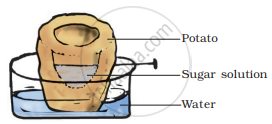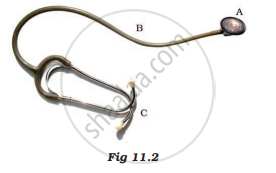Advertisements
Online Mock Tests
Chapters
2: Nutrition in Animals
3: Fibre to Fabric
4: Heat
5: Acids, Bases and Salts
6: Physical and Chemical Changes
7: Weather, Climate and Adaptation of Animals to Climate
8: Wind, Storm and Cyclone
9: Soil
10: Respiration in Organisms
▶ 11: Transportation in Animals and Plants
12: Reproduction in Plants
13: Motion and Time
14: Electric Current and Its Effects
15: Light
16: Water : A Precious Resource
17: Forests : Our Lifeline
18: Wastewater Story
![NCERT Exemplar solutions for Science [English] Class 7 chapter 11 - Transportation in Animals and Plants NCERT Exemplar solutions for Science [English] Class 7 chapter 11 - Transportation in Animals and Plants - Shaalaa.com](/images/science-english-class-7_6:5f2b1b2038084cf381bfa42c826a928c.jpg)
Advertisements
Solutions for Chapter 11: Transportation in Animals and Plants
Below listed, you can find solutions for Chapter 11 of CBSE NCERT Exemplar for Science [English] Class 7.
NCERT Exemplar solutions for Science [English] Class 7 11 Transportation in Animals and Plants MULTIPLE CHOICE QUESTIONS [Pages 57 - 58]
The muscular tube through which stored urine is passed out of the body is called
kidney
ureter
urethra
urinary bladder
They are pipe-like, consisting of a group of specialised cells. They transport substances and form two-way traffic in plants. Which of the following terms qualify for the features mentioned above?
Xylem tissue
Vascular tissue
Root hairs
Phloem tissue
The absorption of nutrients and exchange of respiratory gases between blood and tissues takes place in
veins
arteries
heart
capillaries
In which of the following parts of the human body are sweat glands absent?
Scalp
Armpits
Lips
Palms
In a tall tree, which force is responsible for pulling water and minerals from the soil?
Gravitational force
Transportation force
Suction force
Conduction force
Aquatic animals like fish excrete their wastes in gaseous form as
Oxygen
Hydrogen
Ammonia
Nitrogen
NCERT Exemplar solutions for Science [English] Class 7 11 Transportation in Animals and Plants VERY SHORT ANSWER QUESTIONS [Page 58]
Veins have valves that allow blood to flow only in one direction. Arteries do not have valves. Yet the blood flows in one direction only. Can you explain why?
What is the special feature present in a human heart which does not allow the mixing of blood when oxygen-rich and carbon dioxide-rich blood reaches the heart?
Name the organ which is located in the chest cavity with its lower tip slightly tilted towards the left.
NCERT Exemplar solutions for Science [English] Class 7 11 Transportation in Animals and Plants SHORT ANSWER QUESTIONS [Pages 58 - 59]
Look at Figure 11.1. Draw another figure of the same set-up as would be observed after a few hours.

Arrange the following statements in the correct order in which they occur during the formation and removal of urine in human beings.
(a) Ureters carry urine to the urinary bladder.
(b) Wastes dissolved in water are filtered out as urine in the kidneys.
(c) Urine stored in the urinary bladder is passed out through the urinary opening at the end of the urethra.
(d) Blood containing useful and harmful substances reaches the kidneys for filtration.
(e) Useful substances are absorbed back into the blood.
Paheli uprooted a rose plant from the soil. Most of the root tips, with root hairs, got left behind in the soil. She planted it in a pot with new soil and watered it regularly. Will the plant grow or die? Give a reason for your answer.
Name the only artery that carries carbon dioxide-rich blood.
Why is it called an artery if it does not carry oxygen-rich blood?
Boojho’s uncle was hospitalised and put on dialysis after a severe infection in both of his kidneys.
What is dialysis?
Boojho’s uncle was hospitalised and put on dialysis after a severe infection in both of his kidneys.
When does it become necessary to take such a treatment?
Name the process and the organ which helps in removing the following wastes from the body.
- Carbon dioxide
- Undigested food
- Urine
- Sweat
Observe Figure 11.2 and answer the given questions:

(a) Name the instrument.
(b) Label parts A, B and C.
Paheli noticed water being pulled up by a motor pump to an overhead tank of a five-storeyed building. She wondered how water moves up to great heights in the tall trees standing next to the building. Can you tell me why?
NCERT Exemplar solutions for Science [English] Class 7 11 Transportation in Animals and Plants LONG ANSWER QUESTIONS [Pages 60 - 61]
Match the parts of the heart in Column I with the direction of the flow of blood in Column II.
| Column I | Column II | ||
| (i) | Right ventricle | (a) | Pushes blood into the pulmonary artery. |
| (ii) | Pulmonary veins | (b) | Take deoxygenated blood from the heart to the lungs. |
| (iii) | Left atrium | (c) | Receives blood from different parts of the body. |
| (iv) | Pulmonary arteries | (d) | Bring oxygenated blood from the lungs to the heart. |
| (v) | Left ventricle | (e) | Pushes blood into the aorta. |
| (vi) | Right auricle | (f) | Receives deoxygenated blood from the pulmonary veins. |
Read the following terms given below.
root hairs xylem urethra arteries kidneys veins atria capillaries heart ureter phloem urinary bladder
Group the terms on the basis of the categories given below.
(a) The circulatory system of animals.
(b) Excretory system in humans.
(c) Transport of substances in plants.
Fill in the blanks of the following paragraph using just two words – arteries and veins.
___(a)___ carry oxygen-rich blood from the heart to all parts of the body and ___ (b)___ carry carbon dioxide-rich blood from all parts of the body back to the heart. ___ (c)___ have thin walls and __ (d)___ have thick elastic walls. Blood flows at high pressure in ___ (e)____. Valves are present in __ (f) ___ which allow blood to flow only towards the heart. __ (g)___ divide into smaller vessels. These vessels further divide into extremely thin tubes called capillaries. The capillaries join up to form ____ (h)_____.
While learning to ride a bicycle Boojho lost his balance and fell. He got bruises on his knees and they started bleeding. However, the bleeding stopped after some time.
(a) Why did the bleeding stop?
(b) What would be the colour of the wounded area and why?
(c) Which type of blood cells are responsible for clotting of blood?
Solutions for 11: Transportation in Animals and Plants
![NCERT Exemplar solutions for Science [English] Class 7 chapter 11 - Transportation in Animals and Plants NCERT Exemplar solutions for Science [English] Class 7 chapter 11 - Transportation in Animals and Plants - Shaalaa.com](/images/science-english-class-7_6:5f2b1b2038084cf381bfa42c826a928c.jpg)
NCERT Exemplar solutions for Science [English] Class 7 chapter 11 - Transportation in Animals and Plants
Shaalaa.com has the CBSE Mathematics Science [English] Class 7 CBSE solutions in a manner that help students grasp basic concepts better and faster. The detailed, step-by-step solutions will help you understand the concepts better and clarify any confusion. NCERT Exemplar solutions for Mathematics Science [English] Class 7 CBSE 11 (Transportation in Animals and Plants) include all questions with answers and detailed explanations. This will clear students' doubts about questions and improve their application skills while preparing for board exams.
Further, we at Shaalaa.com provide such solutions so students can prepare for written exams. NCERT Exemplar textbook solutions can be a core help for self-study and provide excellent self-help guidance for students.
Concepts covered in Science [English] Class 7 chapter 11 Transportation in Animals and Plants are Composition of Blood: White Blood Cells (Leukocytes), Composition of Blood: Blood Platelets (Thrombocytes), Blood Vessels, Heart Beat - Heart Sounds "LUBB" and "DUP", Blood Circulatory System in Human, Human Heart, Human Excretory System, Transport System in Plants, Water absorbing organ, Excretion, Complex Permanent Tissues, Complex Permanent Tissue: Phloem Structure and Function (Conducting Tissue), Complex Permanent Tissue: Xylem Structure and Function (Conducting Tissue), Transpiration, Circulation of Blood in the Heart (Functioning of Heart), Blood, Composition of Blood: Red Blood Cells (Erythrocytes).
Using NCERT Exemplar Science [English] Class 7 solutions Transportation in Animals and Plants exercise by students is an easy way to prepare for the exams, as they involve solutions arranged chapter-wise and also page-wise. The questions involved in NCERT Exemplar Solutions are essential questions that can be asked in the final exam. Maximum CBSE Science [English] Class 7 students prefer NCERT Exemplar Textbook Solutions to score more in exams.
Get the free view of Chapter 11, Transportation in Animals and Plants Science [English] Class 7 additional questions for Mathematics Science [English] Class 7 CBSE, and you can use Shaalaa.com to keep it handy for your exam preparation.
